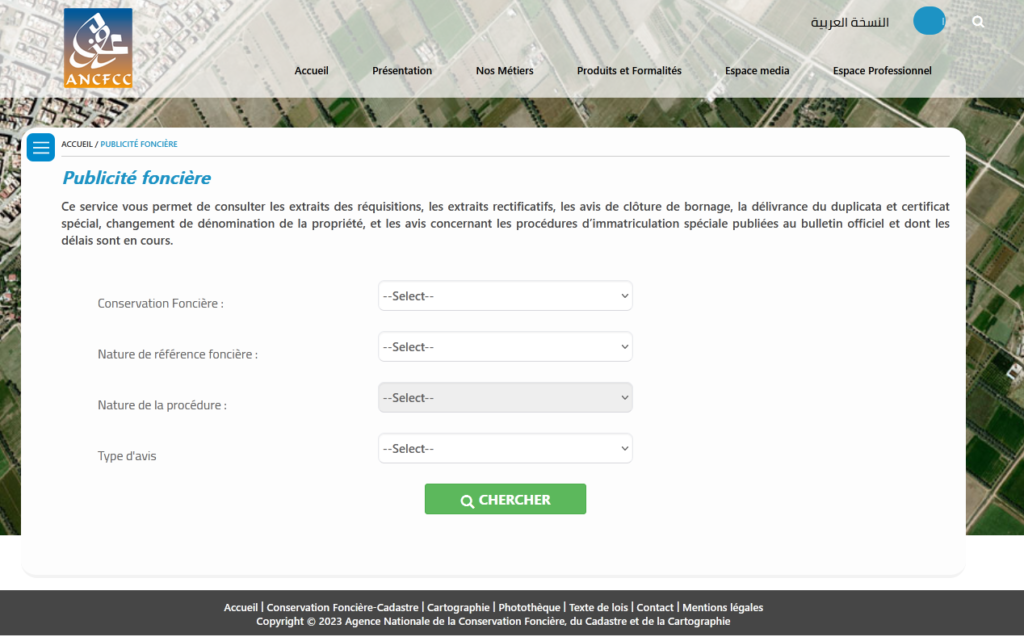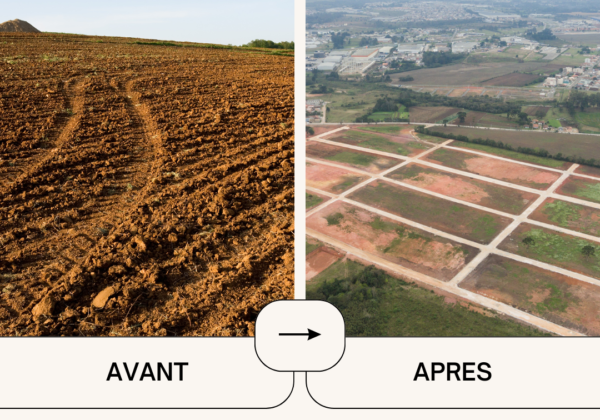Melk, unregistered land ... These terms, familiar to many Moroccans, evoke complex administrative issues. Indeed, behind these expressions lie the crucial steps required to legalize a land situation, thereby giving the land legal and commercial recognition.
Land registration is a set of administrative and legal procedures established by the decree of August 12, 1913. Its main aim? To convert a property Melk property into officially registered land, placing it under the ownership regime established by the aforementioned decree.
Not only does registration secure ownership, it also provides a valuable guarantee, particularly for banks. Most banks will only grant mortgages to owners of registered properties.
Although in theory this procedure is optional for private individuals, once initiated it becomes irrevocable. Although mainly an administrative procedure, it can include a judicial phase, especially if there are objections to registration.
So how do you navigate this administrative and legal labyrinth with confidence? What are the key steps to successful land registration in Morocco? How do you prevent potential objections and ensure a flawless process? Dive in with us as we demystify land registration in Morocco, step by step.

Step 1: Who, when and how to submit your application?
Melk or unregistered land is a common reality in Morocco. Behind this term lies a whole procedure that every owner, whether an individual or a legal entity, must know and master in order to give their property a solid legal and commercial value. But how does one go about this administrative adventure?
-
Who is eligible for the procedure: First of all, it's essential to know who is eligible to apply for registration. The procedure is open not only to owners, but also to partners in a property, as well as to those benefiting from real rights such as the right of usufruct, emphyteutic lease, surface right and other rights mentioned. In addition, in the event of a debt not being repaid when due, based on a court decision, the creditor is also entitled to make a claim.
-
Representation: If you are one of the eligible parties but are unable or unwilling to take personal charge of the procedure, the law allows you to appoint someone else to do so on your behalf. This mandate can be formalized either by a notarial deed, or by agreement attested by a competent authority.
-
Making the application: The application for registration must be made in writing and must contain precise information. Two categories of information must be provided: firstly, details concerning the applicant (identity, status, address, etc.), and secondly, information concerning the property (description, location, surface area, etc.).
-
Examination and acceptance: Once the application has been submitted, it is examined by the land registry. Once the attached documents have been checked and their validity confirmed, the application is registered.
- Final formalities: At the end of this stage, the applicant is provided with a form. This must be filled in with specific information to identify the location of the property to the Land Registry. The Land Registrar then validates the registration fees.
For many homeowners, the process can seem daunting. However, by following these steps and being well informed, land registration can become a simple and straightforward process. So what are the crucial elements to consider to ensure a smooth procedure? How can you ensure that your application is properly formulated and accepted? We guide you through the administrative process.
Step 2: Publication and demarcation when registering a Melk property
Once you've submitted your land registration application, the Registrar of Land Titles takes over. Here's how this essential step in the process works.
1. Publication in the Bulletin Officiel:
As soon as the application is received, the land registrar has ten days to draw up a summary, which is then published in the Bulletin Officiel. The purpose of this step is to inform the public and enable all interested parties to become acquainted with the boundary project.
2. Announcement of demarcation details:
After this publication, the land registrar publishes a second announcement. This announcement indicates the date and time of the demarcation operation, usually scheduled within two months. This process is coordinated with the land registry to ensure accurate measurements and boundaries.
3. Summoning the parties concerned:
In parallel with these publications, the land registrar summons the applicant for registration, local residents and holders of real rights on the land concerned. The aim is to enable all parties to participate actively in the demarcation process.
This second stage of the land registration process is essential to establish indisputably the boundaries and rights attached to the property in question. Once this stage has been completed, the land registrar can move on to the next steps in the registration process.
In short, demarcation is not only an administrative step, but also a technical and legal one, requiring a high level of rigor and expertise. It ensures greater transparency and helps resolve any property disputes that may arise in the future.

Step 3: Boundary marking for thorough validation of the land registration of a Melk property
The land registration procedure is an essential step, combining legality and technicality. The third stage, devoted to technical demarcation, is crucial to guaranteeing the accuracy of files and the legitimacy of land rights.
-
Purpose of demarcation: The main purpose of demarcation is to establish a precise technical boundary for the property, with a view to registering it. Once this has been done, a detailed report is drawn up and published in the Bulletin Officiel. This gives the public transparent access to this information. At the same time, the identity of the owner is clearly defined and a boundary sketch of the property is meticulously drawn up.
-
Boundary marking: This technical aspect is carried out by a land surveyor registered with the national order of land surveyors or by a sworn topographer attached to the land registry. These professionals are responsible for examining the land in detail, defining its current state, placing precise markers (concrete bollards) indicating the property boundaries, and consolidating them. In addition, a detailed demarcation sketch, known as a "provisional demarcation sketch", is drawn up. This document is then appended to the demarcation report and signed by the engineer, the applicant for registration, and all other parties involved in the procedure.
- Transmission of documents: Following these operations, all the documents, including the official report and provisional boundary sketch, are forwarded to the land registry for further processing and formalization.
The demarcation process plays an essential role in ensuring clarity, transparency and accuracy in land registries, thereby reducing the risk of disputes and uncertainties concerning property rights.
Stage 4: From Topographic Survey to Cadastral Plan
Following a meticulous survey, the next step would be to translate and materialize all the information gathered. Surveying and cadastral planning are essential to ensure the accuracy and transparency of land registers.
-
The importance of the surveying operation: Topographic surveying focuses on the precise determination of the property's boundaries, assiette and consistency. It's not just a question of defining the boundaries, but embracing all the features of the property, offering an exhaustive and detailed representation of the parcel.
-
Drawing up the cadastral plan: As a direct consequence of the survey, the cadastral plan is a detailed graphic illustration reflecting all the data collected in the field. To reinforce the reliability of this representation, the plan is backed up by a land register, constituting a harmonized and accurate set of information. These documents are then forwarded to the land registry for formal validation and registration.
- The main players in this phase:
- Internal players: The Land Registry Department plays a central role, coordinating, validating and integrating data.
- Expertise in the field: The expertise of a private-sector land surveyor is essential. It guarantees the rigor of the survey and the accuracy of the cadastral plan.
Each segment of this process underlines the need for impeccable accuracy and competence in land matters. Collaboration between the Land Registry and the private-sector Engineer-Geometer-Topographer is essential to ensure the authenticity of information and the validity of property rights.
Step 5: Formalizing boundaries : From Announcement to Validation
Once the demarcation procedure has been completed and the cadastral plan drawn up, a crucial validation stage is required. This involves a series of notifications and publications to ensure transparency and leave room for any complaints.
-
Publication of the Notice of Closure: Once the demarcation plan has been drawn up, the real estate registrar publishes a notice of the demarcation closure. This notice is not only published in the Bulletin Officiel, but also posted in strategic locations: at the Court of First Instance, at the Local Authority, and at the headquarters of the Communal Council. This dual method of notification guarantees maximum visibility for the parties concerned.
- Opposition period: The introduction of an opposition period is a judicious procedure enabling the various parties to formulate objections or comments. This period is set at two months following publication of the notice in the Bulletin Officiel. Such a period is crucial to avoid subsequent disputes and to ensure transparency in the land registration process.
This step, while procedural, is a guarantee of justice, enabling each party concerned to assert their rights and avoid potential land disputes in the future.

Step 6: The crucial check: Preventing land overlaps
Land registration is more than just a technical demarcation. It is preceded by an essential control phase, designed to avoid any conflict or overlap with previously registered land or land that has been subject to other procedures. This stage is known as definitive surveying.
-
Purpose of the final survey: The main purpose of the final survey is to ensure that the property to be registered does not overlap with another already registered. It also avoids overlapping with adjoining properties or properties that have undergone other legal procedures, such as approved administrative delimitations, areas in the State's public domain, or properties that have been expropriated.
-
A thorough check: This is not a simple verification, but a rigorous check based on precise cadastral data. The operation requires measurement tools and up-to-date mapping, enabling us to identify with certainty any potential overlaps.
- The Artisans of this Verification: The expertise required to carry out this step is provided by qualified professionals. At the heart of this process is the Land Registry, whose technical skills and in-depth knowledge of the land ensure the reliability of the operation.
The final survey phase is thus a key element in the registration process, guaranteeing transparency, authenticity and, above all, social peace by preventing potential land disputes.

Step 7: The Land Registrar's decision
During this crucial stage, the Land Registrar makes a fundamental decision on the land registration application submitted to him. This decision can be broken down into three scenarios:
-
Registration: If all legal formalities have been complied with, the application is in order, the required documents are sufficient, and no objections have been raised, the Land Registrar registers the property. A land title is then issued, confirming the legal status of the property.
-
Cancellation: The Land Registrar may cancel an application for registration in a number of situations, including the absence of the applicant or his representative from the demarcation operations, failure to complete the necessary steps for demarcation, or failure to comply with the procedure within three months of a summons.
- Rejection: In the event of irregularity of the application or inadequacy of the documents provided, the Registrar may reject the application for registration.
If an opposition is lodged, the Registrar forwards the application file to the competent Court of First Instance, which will rule on any oppositions related to ownership.
This step is essential to ensure that only legitimate, law-abiding properties are registered, thus reinforcing the legal security of property rights.
Conclusion: The importance of Initial Preparation
Before starting the process of registering your Melkia plot, the first crucial step is to draw up accurate plans. This process requires professional expertise to ensure that all indications are accurately captured. Our engineering firm takes this responsibility seriously. We'll help you draw up these initial plans, with particular emphasis on the materialization of boundary markers, which will become the foundation on which the entire registration procedure rests. This preparatory stage is essential, as it enables you to know precisely the area to be declared at the initial meeting with the land authorities.
Assistance focused on demarcation
One of the most critical stages in the registration process is the demarcation. It is at this stage that the exact boundaries of your property are established and validated. Our team will assist you throughout this stage, working closely with the land registry to ensure that every boundary marker is correctly placed and that every detail is taken into account.
Support during the Topographic Survey
Once demarcation has been completed, the procedure continues with the topographical survey. Accuracy is paramount here. Any oversight or negligence at this stage could lead to inconsistencies in the future. Our role is to make sure this doesn't happen. We're with you every step of the way, making sure that the surface area delineated and registered by the land registry is exactly the same as the one you declared on day one.
Thanks to this rigorous, methodical approach, we ensure that every step of the process is managed with the utmost precision, avoiding any risk of error or omission. With our support, you can rest assured that your Melkia land will be registered in full compliance with current regulations, guaranteeing your rights as an owner.
Contact us today. Our team of experts is here to provide you with the advice and assistance you need to avoid surprises and ensure the successful registration of your land. Call us, send us a message on WhatsApp (+212) 6 60 41 02 18 or e-mail([email protected]), and benefit from our expertise to bring your project to fruition with complete peace of mind.




5 thoughts on "Title Your Melk Plot in Morocco in 2024: Follow these 7 Unmissable Steps!"